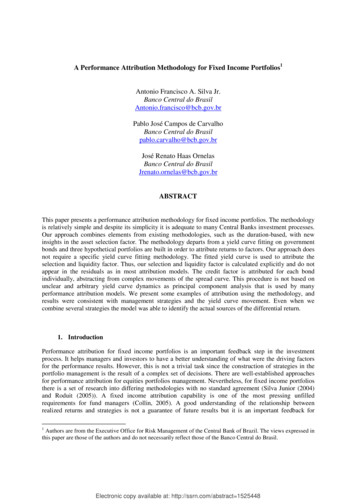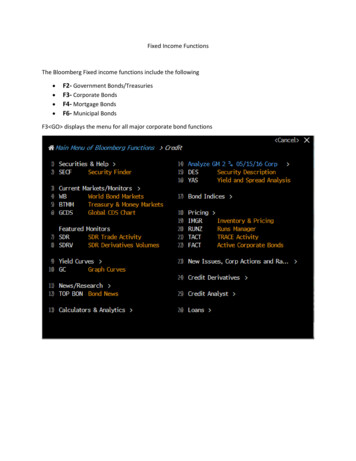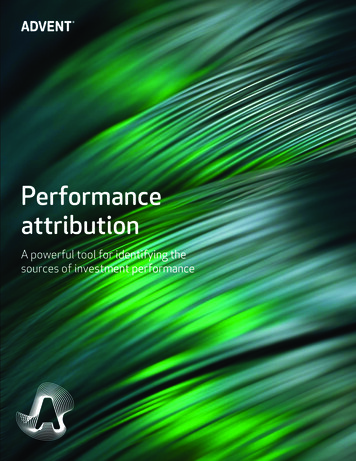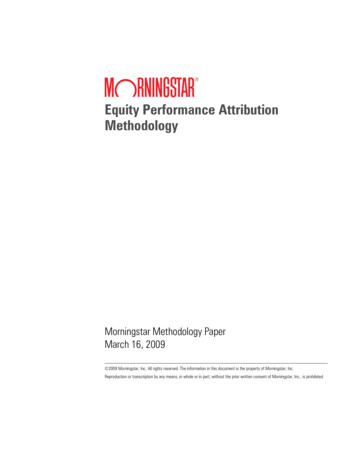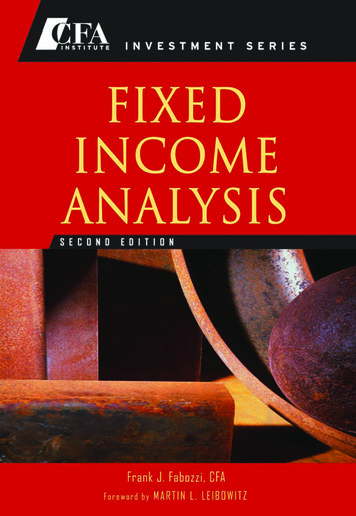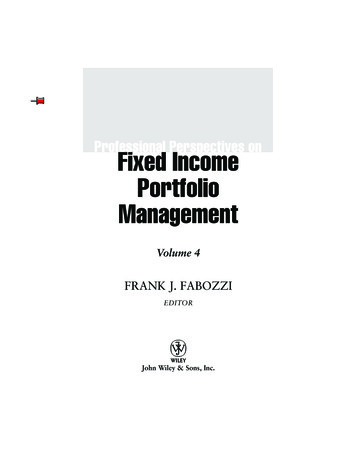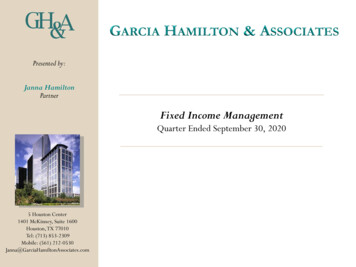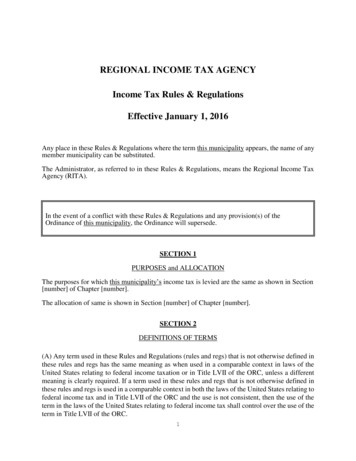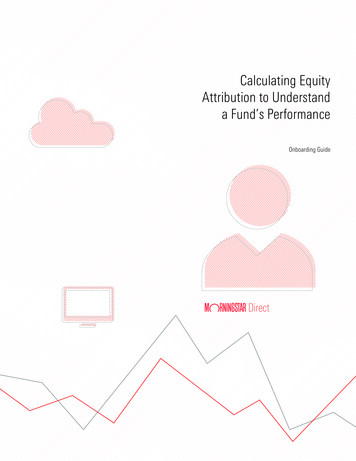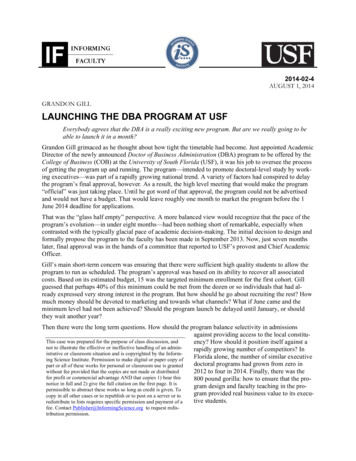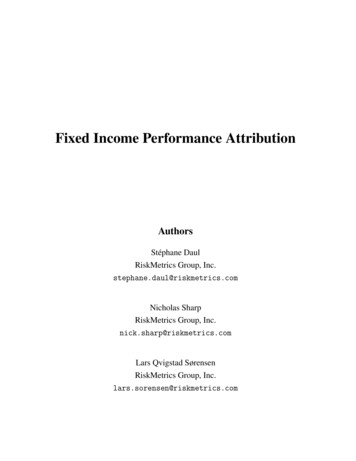
Transcription
Fixed Income Performance AttributionAuthorsStéphane DaulRiskMetrics Group, Inc.stephane.daul@riskmetrics.comNicholas SharpRiskMetrics Group, Inc.nick.sharp@riskmetrics.comLars Qvigstad SørensenRiskMetrics Group, Inc.lars.sorensen@riskmetrics.com
Contents1 Introduction32 Total Return52.1Payments . . . . . . . . . . . . . . . . . . . . . . . . . . . . . . . . . . . . . . . . .52.2Transactions . . . . . . . . . . . . . . . . . . . . . . . . . . . . . . . . . . . . . . . .72.3Currency . . . . . . . . . . . . . . . . . . . . . . . . . . . . . . . . . . . . . . . . .73 Factor Model93.1Factor duration . . . . . . . . . . . . . . . . . . . . . . . . . . . . . . . . . . . . . .103.2Currency . . . . . . . . . . . . . . . . . . . . . . . . . . . . . . . . . . . . . . . . .113.2.1Forward premium and currency surprise . . . . . . . . . . . . . . . . . . . . .133.3Carry . . . . . . . . . . . . . . . . . . . . . . . . . . . . . . . . . . . . . . . . . . .153.4Yield curve . . . . . . . . . . . . . . . . . . . . . . . . . . . . . . . . . . . . . . . .163.4.1Effective duration and convexity . . . . . . . . . . . . . . . . . . . . . . . . .173.4.2Key-rate durations . . . . . . . . . . . . . . . . . . . . . . . . . . . . . . . .183.5Credit . . . . . . . . . . . . . . . . . . . . . . . . . . . . . . . . . . . . . . . . . . .223.6Volatility . . . . . . . . . . . . . . . . . . . . . . . . . . . . . . . . . . . . . . . . .263.7Inflation . . . . . . . . . . . . . . . . . . . . . . . . . . . . . . . . . . . . . . . . . .291
2456Relative Performance Attribution334.1Introduction . . . . . . . . . . . . . . . . . . . . . . . . . . . . . . . . . . . . . . . .334.2Pure asset-grouping approach . . . . . . . . . . . . . . . . . . . . . . . . . . . . . . .354.3Pure factor model approach . . . . . . . . . . . . . . . . . . . . . . . . . . . . . . . .364.4Hybrid attribution model . . . . . . . . . . . . . . . . . . . . . . . . . . . . . . . . .374.5Multi-period attribution . . . . . . . . . . . . . . . . . . . . . . . . . . . . . . . . . .414.6Impact of pricing difference . . . . . . . . . . . . . . . . . . . . . . . . . . . . . . .43Exposures455.1Partial and full exposure . . . . . . . . . . . . . . . . . . . . . . . . . . . . . . . . .455.2Performance legs and notional cash . . . . . . . . . . . . . . . . . . . . . . . . . . .465.3Portfolio weight . . . . . . . . . . . . . . . . . . . . . . . . . . . . . . . . . . . . . .465.4Other derivatives . . . . . . . . . . . . . . . . . . . . . . . . . . . . . . . . . . . . .49Benchmarks516.1Introduction . . . . . . . . . . . . . . . . . . . . . . . . . . . . . . . . . . . . . . . .516.2Benchmark rules . . . . . . . . . . . . . . . . . . . . . . . . . . . . . . . . . . . . .526.2.1Selection criteria . . . . . . . . . . . . . . . . . . . . . . . . . . . . . . . . .536.2.2Rebalancing . . . . . . . . . . . . . . . . . . . . . . . . . . . . . . . . . . . .536.2.3Total return . . . . . . . . . . . . . . . . . . . . . . . . . . . . . . . . . . . .546.2.4Index calculation . . . . . . . . . . . . . . . . . . . . . . . . . . . . . . . . .546.3Data . . . . . . . . . . . . . . . . . . . . . . . . . . . . . . . . . . . . . . . . . . . .556.4Replicating returns . . . . . . . . . . . . . . . . . . . . . . . . . . . . . . . . . . . .576.5Validation of benchmark data . . . . . . . . . . . . . . . . . . . . . . . . . . . . . . .59
Chapter 1IntroductionPerformance attribution is a set of techniques used by portfolio managers for the purpose of measuringand explaining portfolio performance relative to a benchmark. The objective is to quantify the impactthat active management decisions have on the relative performance (i.e. active return) over a giveninterval of time.Each decision taken by the portfolio manager is associated with an attribution effect that quantitatively measures the amount by which the decision affects the relative performance. The attributioneffects aggregate together to fully account for the active return. Because attribution effects describe theimpact of active management decisions it is important that the attribution model reflects the decisionmaking process. A long-only government bond portfolio is certainly managed differently from anemerging-market portfolio, or a credit derivatives portfolio.The standard attribution methodology, introduced by Brinson and Fachler (1985), attributes theactive return to asset allocation and security selection decisions. The methodology boils down togrouping positions in a reference portfolio in such a way to make the attribution effects apparent, andhence its current name, the asset-grouping approach. This approach has been widely extended and isparticularly well suited for equity portfolios. 1However for fixed-income portfolios this approach is not as successful. Fixed-income managersneed specialized attribution models that for example incorporate all the effects of yield-curve movements. For instance it is difficult to find any reference portfolio that captures only a butterfly effect ofthe yield curve. Another route is the factor based approach, where the performance of all securities isfirst decomposed using systematic factors and then aggregated. We consider a configurable, extendable1 Thisis actually the approach that RiskMetrics has taken for equity attribution, see Soor (2010).
4CHAPTER 1. INTRODUCTIONhybrid approach to fixed-income performance attribution where attribution is decomposed into manyfixed-income factors as well as simultaneously carrying out an asset-grouping approach to performanceattribution where necessary.To present the content of this review paper, we show what an attribution report could look likein Table 1.1. This fictious example presents a portfolio of fixed income instruments along with theirrelative attribution to the benchmark. We start by calculating the total return of each securities asshown in Chapter 2, and report the active return (I), i.e. the security return relative to the benchmark.The active return is then decomposed (II) using the fixed income factor model developed in Chapter3. The factors may not capture all investment decisions, and we apply an asset-grouping approach onthe residual (III) as detailed in Chapter 4. Finally we look in more details at how exposures need to becalculated in Chapter 5 and we analyze benchmarks in Chapter 6.Table 1.1Illustrative attribution report(I)Security ASecurity BSecurity CSecurity DSecurity ESecurity FSecurity GSecurity HSecurity ISecurity JSecurity KSecurity LSecurity MTotal(II)(III)Active ReturnCurrencyCarryYield 0.009%0.030%0.032%-0.048%-0.036%0.213%0.004%0.154%
Chapter 2Total ReturnThe total return is the percentage change in the value of a security resulting from changes in the marketvalue of the security, interest income accrued or received, and reinvestment income over the attributionperiod. The attribution period is defined as the time that elapses between the start date t1 and end datet2 .The total return rtotal of a fixed-income security (in the security’s local currency) over the attributionperiod [t1 ,t2 ] is defined asV (t2 ) V (t1 ) C(t1 ,t2 )rtotal ,(2.1)V (t1 )where V (t1 ) is the market value (this is the dirty/invoice price in the case of bonds) of the security atthe start of the attribution period, and similarly V (t2 ) is the market value of the security at the end ofthe attribution period. Also, C(t1 ,t2 ) is the sum of payments received during the attribution period.2.1 PaymentsThere are two sources of cash that accumulate in a portfolio, these are coupon payments and principalpayments, the latter includes both scheduled and unscheduled prepayments.Coupon paymentsInterest income in the form of coupon payments is the most common form of cash that accumulates inthe portfolio. This form of payment represents the interest income the holder is entitled to based on
6CHAPTER 2. TOTAL RETURNthe total par amount outstanding. The structure and frequency of coupon payments will vary betweensecurities. Examples include U.S. Treasury securities which pay semi-annual coupons and MBS fixedrate passthrough securities which pay monthly coupons. These are two examples of fixed-couponsecurities, there are other coupon types such as floating coupons, step coupons, or inflation-linkedcoupons where the coupon rate must be multiplied by the appropriate index ratio.Principal paymentsThe three types of principals payments that must also be accounted for when calculating the total returnare:1. Sinking funds – Bonds with sinking fund schedules make partial principal payments prior to thebond’s maturity date.2. Called securities – Bonds with a call provision allow the issuer to buy (call) back the bond at aspecified price at specified points in the future. Bonds may be fully or partially called. Beingcalled corresponds to cash at the call price entering the portfolio.3. Principal prepayments – Principal can be paid early in the form of unscheduled prepayments forsecuritized products (MBS, ABS and CMBS). The timing of prepayments and the time of cashactually entering the portfolio will vary from security to security.Reinvestment of coupon paymentsPayments received are typically reinvested at the reinvestment rate re (tc ) asC(t1 ,t2 ) Ctc · [1 re (tc )](t2 tc ) ,(2.2)tc [t1 ,t2 ]where payments received, Ctc , are coupon payments or principal payments paid during the attributionperiod [t1 ,t2 ], and tc is the time of a payment. It is possible that the payments received, Ctc , are reinvested at the reinvestment rate re (tc ), e.g. the 1-month LIBID rate (with daily compounding) as of theprior month-end. In this case the number of days between the receipt of the cash flow and the end ofthe attribution period is t2 tc .It is also permissible that a policy of not reinvesting payments received is followed. On one hand,investors may be able to outperform a benchmark if they reinvest cash but on the other hand, they mayalso underperform by having to pay transaction costs where a benchmark does not.
Transactions2.2 TransactionsSo far we have assumed that performance measurement has been carried out on a static portfolio basis,i.e. the return is calculated based on holdings snapshots at t1 and t2 . A more relevant approach is totake account of all transactions that affect the portfolio. This would allow the contribution of tradingactivity to the total return to be determined.To perform transaction-based attribution, we can choose the attribution period to be daily so thatthe effect of all transactions are applied at the correct time. For a transaction-based approach the totalreturn (2.1) of a security is such thatrtotal V (t 1) V (t) C(t,t 1) P(t) S(t),V (t)(2.3)where P(t) and S(t) are purchases made and sales made on day t, respectively.1 For information on theimplementation of RiskMetrics transactions-based approach see Soor and Costigan (2010).It is well known that return calculations based on the buy-and-hold approach are very approximate(see Vann, 1999, for a study supporting this claim) when compared with calculations that take intraattribution period changes in portfolio holdings into account. Buy-and-hold return calculation is stillvery important though as the difference between this and the transaction-based return gives a measureof the value added from transactions, and as such is an integral aspect of attribution analysis.2.3 CurrencyIf a bond is denominated in a currency different from the portfolio’s base currency, then part of thereturn will be due to foreign exchange rate movements. This is treated as a separate component of thereturn and will be part of our factor model. The total return (in base currency) of a security is definedlocal asas the currency return rcurrency , plus the local total return rtotallocalbase. rcurrency rtotalrtotal(2.4)The currency return comprises the currency appreciation and its cross product with the local totalreturn. Further details are provided in Section 3.2.1 Thisformulation assumes that external cash flows occur at the end of the day. Assumptions regarding intra-day cashflows are also permissible.7
8CHAPTER 2. TOTAL RETURN
Chapter 3Factor ModelIn order to decompose total returns, we need a model that describes how changes in specific factorsaffect returns. Models provide approximations to a complex real world. Each model has pros andcons, and there are always tradeoffs involved when choosing one particular model over another. Inaddition, some models may perform well under certain market conditions but poorly under other marketconditions. Therefore, a solution that offers the user flexibility is proposed. We want to attribute returnsbetween times t1 and t2 to various decisions taken by the portfolio manager. A common factor model isbased on the premise that there exist common factors which affect prices on large classes of securities.A security’s price change as a response to a factor is determined by the security’s sensitivity to thefactor. At a given time, a factor model with K factors for a security i takes the formKri βi,k fk εi,(3.1)k 1where ri is the total return on security i, fk is the return of factor k, βi,k represents the sensitivity ofsecurity i to a movement in factor k, and εi is the residual return that cannot be explained by factors. Wecan decompose returns into a systematic and an idiosyncratic component. The systematic component isthe part of the return that is attributable to exposure to factors. The residual is the part of the return thatremains after the factor return decomposition. It contains the idiosyncratic component and whatever isnon-attributable because of data problems. Note that the factor return, fk , is common across all assetsand buckets.
10CHAPTER 3. FACTOR MODEL3.1Factor durationThere are several ways to measure factor sensitivities and factor realizations. One class of models estimates factor returns by cross-sectional linear regressions, similar to the procedure in Fama and MacBeth(1973). Another class of models constructs factor returns from observable variables and then estimatesfactor sensitivities by linear regressions. The advantage of this method is that it does not require sophisticated pricing functions. The drawback is that the estimated factors or their sensitivities do notnecessarily correspond to concepts portfolio managers can relate to.Our approach differs from the two above. Our factors are the actual observed changes in the riskfactors. We have pricing functions for all fixed income instruments. The sensitivity to a change ina factor is found by repricing the security after applying shifts to the factor. This provides a moreintuitive way to assess the sources of returns as the actual factors are used instead of latent variables.The cost, however, is that our approach is more computationally demanding.To set the stage, assume that the market value of a fixed income instrument is a function of N riskfactorsV g(x1 , x2 , . . . , xN ).(3.2)The effect on market value of small changes in the factors can be approximated with a second orderTaylor series expansionN g1 N N 2g V xk xk xℓ .(3.3)2 k 1 ℓ 1 xℓ xkk 1 xkTypically, cross terms are ignored so that the expression simplifies to V N g1N 2g xk xk 2 x2 xk2.k 1k 1(3.4)kThe first order terms are referred to as durations with respect to a specific factor and the second orderterms are referred to as convexities. Convexities capture the fact that the relation between a bond’sprice and the factor change is non-linear. We define the factor duration as the negative of the percentsensitivity of the security’s price with respect to a small shift in the factor. The factor duration withrespect to factor i is thus1 V,(3.5)Dk V xkwhere V / xk represents the derivative of the security price with respect to the factor, i.e. the factorsensitivity. The return contribution from a specific factor k is thus given byrfactor k Dk fk ,(3.6)
Currencywhere fk xk is the ex-post realized return on factor k.The decomposition of returns can be thought of as a process where returns are attributed to factorssuccessively. For each security in the portfolio, we decompose the local total return into the followingcomponents:1. Currency: Each portfolio has a base currency in which market values are computed. If a bondis denominated in a currency different from the base currency, then part of the return in basecurrency will be due to foreign exchange rate movements. These are separated and treated as aseparate factor. Further details are provided in Section 3.2.2. Carry: The carry captures the part of a bond’s return that is due simply to the passage of time.It typically consists of two components: the income that accrues to the holder of the bond overtime and the change in clean price, provided that the yield curve remains the same. Both theseeffects are detailed in Section 3.3.3. Yield curve: The yield curve return is the return on the bond that is due to changes in thegovernment yield curve. For regular bonds, this is typically one of the most important factors. Itis discussed further in Section 3.44. Credit: Investors buying bonds that are not backed by the full faith and credit of a governmentnot subject to default risk, will command a premium to take on the risk of not getting back allpromised coupons and principal. Widening or tightening of credit spreads will impact the returnson such bonds and is treated in Section 3.5.5. Volatility: The volatility return captures the change in a fixed income security’s price becauseof changes in volatility. This component can be significant for options and instruments that haveembedded options. It is discussed more in Section 3.66. Inflation: Changes in the nominal yield curve can be due to changes in the real interest rateor changes concerning expectations about inflation and associated risk premia. Section 3.7 details how we can decompose the yield curve return into a real rate component and a break-eveninflation component.3.2 CurrencyIn the case of multi-currency portfolios the local currency of a security will often be different from thebase currency of the portfolio and there will be a contribution to the total return from movements in the11
12CHAPTER 3. FACTOR MODELforeign exchange rate during the attribution period. Hence, we separate out the component of returndue to currency movements, rcurrency , as shown in Eq. (2.4).The total return of a security expressed in terms of the local currency and the exchange rate fromlocal to base currency can be found as follows. First let us consider an investor who buys foreigncurrency at time t1 and sells the position back in base currency at time t2 , the currency appreciation rFX ,or the realized return from this investment in foreign currency, is defined as:rFX χ (t2 ) χ (t1 ),χ (t1 )(3.7)where χ (t1 ) and χ (t2 ) are the exchange rates from local currency to base currency at the beginning andthe end of the holding period, respectively.For an investor who buys a security denominated in a foreign currency whose market value in thelocal currency is V (t) and where the exchange rate f
Fixed Income Performance Attribution Authors Stephane Daul RiskMetrics Group, Inc. stephane.da
